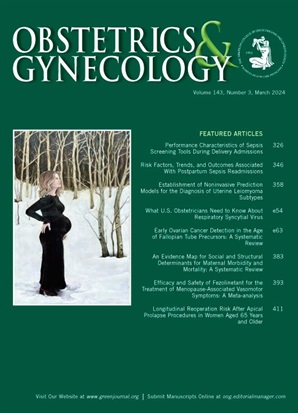Racial Disparities in Endometriosis and Pelvic Pain Treatment Within an Integrated Health Care Delivery System.
IF 4.7
2区 医学
Q1 OBSTETRICS & GYNECOLOGY
引用次数: 0
Abstract
OBJECTIVE To assess disparities in medical and surgical management of endometriosis and pelvic pain disorders, focusing on Black individuals and individuals from other racial and ethnic groups within an integrated health care delivery system. METHODS We conducted a retrospective cohort study of women aged 18 years or older with a pelvic pain disorder, including endometriosis, pelvic pain, dysmenorrhea, and dyspareunia, coded in the electronic health record (EHR) between 2012 and 2019 within Kaiser Permanente Northern California. Demographic, clinical, and treatment characteristics were assessed overall and by patient race and Black compared with other racial and ethnic groups as coded in the EHR. RESULTS Of 15,164 eligible women, 1,707 (11.3%) were Black and 13,457 (88.7%) were non-Black, including 44.4% White patients, 13.8% Asian patients, 24.8% Hispanic patients, and 5.7% patients from other or unknown racial and ethnic groups. Black compared with non-Black women were younger (median [interquartile range] age 36 years [28-44 years] vs 37 years [30-45 years], P<.001), had a higher median [interquartile range] body mass index (BMI) (29.8 [25.2-35.9] vs 26.0 [22.7-30.7], P<.001), and had similar parity. Compared with non-Black women, a higher proportion of Black women received hormonal therapy (56.2% vs 51.9%, P=.001), pain medications (55.4% vs 44.7%, P=.001), and surgery (25.5% vs 23.0%, P=.02). A smaller proportion of all non-White women were referred to a pelvic pain physician specialist compared with White women (P=.001), with Black women referred at lower rates (14.9% vs 18.4%, P=.001). CONCLUSION Black women in this integrated health care system received more hormonal, pain, and surgical management for endometriosis than non-Black women. However, there was a lower referral rate to pelvic pain physician specialists among all non-White women compared with White women, which highlights the need to better understand care allocation.在综合医疗服务系统中子宫内膜异位症和盆腔疼痛治疗的种族差异。
目的评估子宫内膜异位症和盆腔疼痛疾病的内科和外科治疗的差异,重点关注黑人和其他种族和族裔群体在综合医疗保健服务系统中的差异。方法:我们对2012年至2019年在北加州凯撒医疗机构进行了一项回顾性队列研究,研究对象为18岁及以上患有盆腔疼痛疾病的女性,包括子宫内膜异位症、盆腔疼痛、痛经和性交困难,并在电子健康记录(EHR)中进行了编码。总体评估了人口统计学、临床和治疗特征,并根据患者种族和黑人与EHR中编码的其他种族和族裔群体进行了比较。结果在15164名符合条件的女性中,黑人1707人(11.3%),非黑人13457人(88.7%),其中白人44.4%,亚裔13.8%,西班牙裔24.8%,其他或未知种族和族裔5.7%。与非黑人妇女相比,黑人妇女更年轻(年龄中位数[四分位数范围]36岁[28-44岁]vs 37岁[30-45岁],P<.001),身体质量指数(BMI)中位数[四分位数范围]更高(29.8 [25.2-35.9]vs 26.0 [22.7-30.7], P<.001),胎次相似。与非黑人女性相比,黑人女性接受激素治疗(56.2%比51.9%,P= 0.001)、止痛药治疗(55.4%比44.7%,P= 0.001)和手术治疗(25.5%比23.0%,P= 0.02)的比例更高。与白人妇女相比,所有非白人妇女转诊给骨盆疼痛专科医师的比例较小(P= 0.001),黑人妇女转诊的比例较低(14.9%对18.4%,P= 0.001)。结论在这个综合医疗保健系统中,黑人妇女比非黑人妇女接受了更多的激素、疼痛和手术治疗。然而,与白人女性相比,所有非白人女性盆腔疼痛专科医师的转诊率较低,这突出了更好地了解护理分配的必要性。
本文章由计算机程序翻译,如有差异,请以英文原文为准。
求助全文
约1分钟内获得全文
求助全文
来源期刊

Obstetrics and gynecology
医学-妇产科学
CiteScore
11.10
自引率
4.20%
发文量
867
审稿时长
1 months
期刊介绍:
"Obstetrics & Gynecology," affectionately known as "The Green Journal," is the official publication of the American College of Obstetricians and Gynecologists (ACOG). Since its inception in 1953, the journal has been dedicated to advancing the clinical practice of obstetrics and gynecology, as well as related fields. The journal's mission is to promote excellence in these areas by publishing a diverse range of articles that cover translational and clinical topics.
"Obstetrics & Gynecology" provides a platform for the dissemination of evidence-based research, clinical guidelines, and expert opinions that are essential for the continuous improvement of women's health care. The journal's content is designed to inform and educate obstetricians, gynecologists, and other healthcare professionals, ensuring that they stay abreast of the latest developments and best practices in their field.
 求助内容:
求助内容: 应助结果提醒方式:
应助结果提醒方式:


